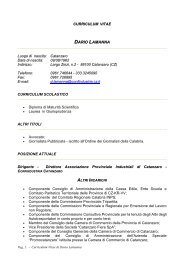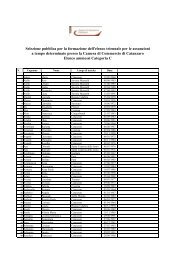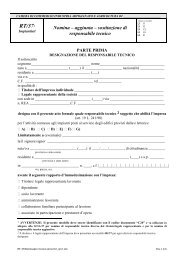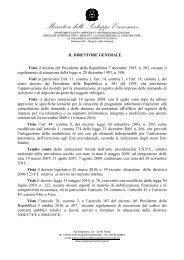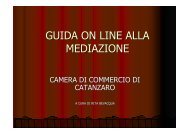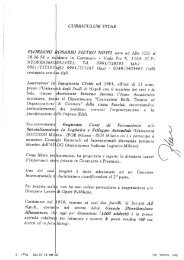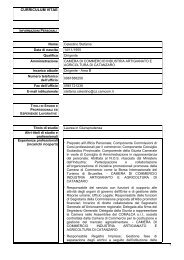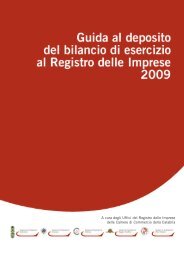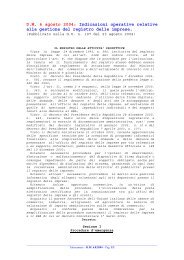numero 2 anno 2013 - CCIAA di Catanzaro - Camera di Commercio
numero 2 anno 2013 - CCIAA di Catanzaro - Camera di Commercio
numero 2 anno 2013 - CCIAA di Catanzaro - Camera di Commercio
You also want an ePaper? Increase the reach of your titles
YUMPU automatically turns print PDFs into web optimized ePapers that Google loves.
Box 2: “Exploring the relationship between CDS and rating <strong>anno</strong>uncements: a literature<br />
review and future research <strong>di</strong>rections”<br />
I risultati <strong>di</strong> un lavoro <strong>di</strong> ricerca, svolto da un team <strong>di</strong> stu<strong>di</strong>osi dell’Ateneo catanzarese - Prof.ssa Annarita Trotta e dott.<br />
sse Rosella Carè e Giusy Cavallaro, dal titolo “Exploring the relationship between CDS and rating <strong>anno</strong>uncements:<br />
a literature review and future research <strong>di</strong>rections” sarà presentato al convegno internazionale: “3rd International<br />
Conference on Economics and Finance”. Izmir (Turchia) - 26-27 aprile, <strong>2013</strong> - http://www.icefconference.net/<br />
Di seguito, un abstract della ricerca:<br />
Cre<strong>di</strong>t derivatives, and in particular the category of CDS, present some interesting features, which allow an analysis<br />
of how the public and private information affects the market prices. In particular: i) the CDS spreads represent the<br />
<strong>di</strong>rect prices of cre<strong>di</strong>t risk (Galil et al., 2011), ii) CDSs are by far the most liquid instrument in the family of cre<strong>di</strong>t<br />
derivatives, iii) the increasing harmonization of CDS contracts allows a <strong>di</strong>rect comparison (Cossin et al., 2006). The<br />
growing interest of the literature towards the cre<strong>di</strong>t derivatives market is due, therefore, to the characteristics of these<br />
contracts that make them potentially more efficient than other financial instruments in establishing the “right” price<br />
of cre<strong>di</strong>t risk (Di Cesare, 2006). For this reason, researchers have begun to explore the relationship between cre<strong>di</strong>t<br />
default swap (CDS) and rating <strong>anno</strong>uncements. Over the last decade it is possible to find in the literature an interesting<br />
number of work focused on such topic. Norden and Weber (2004), show the ability of markets to anticipate<br />
changes in the rating and a greater impact in the case in which S&P and Moody’s have operated the variations.<br />
Moreover, the abnormal performance would be influenced by the level of the old rating. Hull et al. (2004) point<br />
out that the CDS market anticipates all three types of negative cre<strong>di</strong>t events (downgrade, review for downgrade,<br />
negative outlook). Micu et al. (2006), instead, highlight as all types of rating <strong>anno</strong>uncements, whether negative<br />
or positive, have a significant impact on CDS spreads. They argued that the impact is greatest for firms with split<br />
ratings, smallcap firms and firms rated near the threshold of investment grade. Afterwards Norden (2009), show<br />
that the CDS market quickly and accurately incorporates public information and that rating <strong>anno</strong>uncements are<br />
particularly informative when informational asymmetries are elevated. Chava et al. (2012) point out that the stock<br />
and bond markets seem to perceive the CDS as a viable alternative to cre<strong>di</strong>t ratings. Furthermore, the contribution<br />
of Castellano and Scaccia (2012) appears interesting. In such study CDS quotes and volatilities increase before<br />
negative <strong>anno</strong>uncements. The authors, moreover, show that <strong>anno</strong>uncements made by CRAs, in most of the cases, do<br />
not seem to convey extra information but simply reflect information already <strong>di</strong>scounted by the market. The results of<br />
this work, at the same time, seem to <strong>di</strong>sclose some changing in the CDS signaling power during the financial crisis.<br />
Over the last ten years an increasing number of researches focused on this topic highlighted the ability of the CDS<br />
market to incorporate new information much faster than the <strong>anno</strong>uncements of CRAs. However, despite the attention<br />
paid by scholars on the subject, the existing contributions are still deeply heterogeneous for dataset type and<br />
methodology used. Starting from these considerations, this study aims to <strong>di</strong>scuss the information/pre<strong>di</strong>ctive ability<br />
of CDS to react to rating <strong>anno</strong>uncements through the systematization of the existing contributions in the literature<br />
outlining a comprehensive framework to identify the main issues dealt with, any links and/or common results. The<br />
method used in this work is a process of systematic literature review, based on three stage procedure: data collection,<br />
data analysis and synthesis of the results. The aim of conducting a literature review is to enable the researcher both<br />
to map and to assess the existing knowledge. The systematic nature of such procedure improves the quality of the<br />
review process and the results obtained through the use of this transparent and reproducible method (Tranfield et<br />
al., 2003). The results of our work could provide in<strong>di</strong>cations of a prescriptive nature to scholars and policy makers<br />
to assess the cre<strong>di</strong>t risk, role of rating agencies, information content of cre<strong>di</strong>t derivatives and on the role of CDS in<br />
the financial industry. Cre<strong>di</strong>t derivatives, and in particular the category of CDS, present some interesting features,<br />
which allow an analysis of how the public and private information affects the market prices. In particular: i) the CDS<br />
spreads represent the <strong>di</strong>rect prices of cre<strong>di</strong>t risk (Galil et al., 2011), ii) CDSs are by far the most liquid instrument<br />
in the family of cre<strong>di</strong>t derivatives, iii) the increasing harmonization of CDS contracts allows a <strong>di</strong>rect comparison<br />
(Cossin et al., 2006). The growing interest of the literature towards the cre<strong>di</strong>t derivatives market is due, therefore,<br />
to the characteristics of these contracts that make them potentially more efficient than other financial instruments in<br />
establishing the “right” price of cre<strong>di</strong>t risk (Di Cesare, 2006). For this reason, researchers have begun to explore the<br />
relationship between cre<strong>di</strong>t default swap (CDS) and rating <strong>anno</strong>uncements. Over the last decade it is possible to find<br />
in the literature an interesting number of work focused on such topic. Norden and Weber (2004), show the ability of<br />
markets to anticipate changes in the rating and a greater impact in the case in which S&P and Moody’s have operated<br />
the variations. Moreover, the abnormal performance would be influenced by the level of the old rating. Hull et<br />
al. (2004) point out that the CDS market anticipates all three types of negative cre<strong>di</strong>t events (downgrade, review for<br />
downgrade, negative outlook). Micu et al. (2006), instead, highlight as all types of rating <strong>anno</strong>uncements, whether<br />
negative or positive, have a significant impact on CDS spreads. They argued that the impact is greatest for firms<br />
with split ratings, smallcap firms and firms rated near the threshold of investment grade. Afterwards Norden (2009),<br />
show that the CDS market quickly and accurately incorporates public information and that rating <strong>anno</strong>uncements<br />
are particularly informative when informational asymmetries are elevated. Chava et al. (2012) point out that the<br />
stock and bond markets seem to perceive the CDS as a viable alternative to cre<strong>di</strong>t ratings. Furthermore, the contribution<br />
of Castellano and Scaccia (2012) appears interesting. In such study CDS quotes and volatilities increase<br />
before negative <strong>anno</strong>uncements. The authors, moreover, show that <strong>anno</strong>uncements made by CRAs, in most of the<br />
cases, do not seem to convey extra information but simply reflect information already <strong>di</strong>scounted by the market.<br />
The results of this work, at the same time, seem to <strong>di</strong>sclose some changing in the CDS signaling power during the<br />
financial crisis. Over the last ten years an increasing number of researches focused on this topic highlighted the<br />
ability of the CDS market to incorporate new information much faster than the <strong>anno</strong>uncements of CRAs. However,<br />
despite the attention paid by scholars on the subject, the existing contributions are still deeply heterogeneous for<br />
dataset type and methodology used. Starting from these considerations, this study aims to <strong>di</strong>scuss the information/<br />
pre<strong>di</strong>ctive ability of CDS to react to rating <strong>anno</strong>uncements through the systematization of the existing contributions in<br />
the literature outlining a comprehensive framework to identify the main issues dealt with, any links and / or common<br />
results. The method used in this work is a process of systematic literature review, based on three stage procedure:<br />
data collection, data analysis and synthesis of the results. The aim of conducting a literature review is to enable the<br />
researcher both to map and to assess the existing knowledge. The systematic nature of such procedure improves the<br />
quality of the review process and the results obtained through the use of this transparent and reproducible method<br />
(Tranfield et al., 2003). The results of our work could provide in<strong>di</strong>cations of a prescriptive nature to scholars and<br />
policy makers to assess the cre<strong>di</strong>t risk, role of rating agencies, information content of cre<strong>di</strong>t derivatives and on the<br />
role of CDS in the financial industry.



